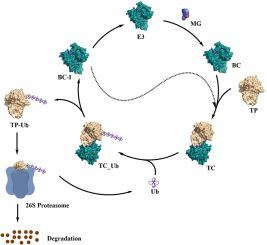当前位置:
X-MOL 学术
›
Bioorg. Med. Chem.
›
论文详情
Our official English website, www.x-mol.net, welcomes your
feedback! (Note: you will need to create a separate account there.)
Crbn-based molecular Glues: Breakthroughs and perspectives
Bioorganic & Medicinal Chemistry ( IF 3.3 ) Pub Date : 2024-03-18 , DOI: 10.1016/j.bmc.2024.117683
Juzeng An 1 , Xiaojun Zhang 2
Bioorganic & Medicinal Chemistry ( IF 3.3 ) Pub Date : 2024-03-18 , DOI: 10.1016/j.bmc.2024.117683
Juzeng An 1 , Xiaojun Zhang 2
Affiliation

|
CRBN is a substrate receptor for the Cullin Ring E3 ubiquitin ligase 4 (CRL4) complex. It has been observed that CRBN can be exploited by small molecules to facilitate the recruitment and ubiquitination of non-natural CRL4 substrates, resulting in the degradation of neosubstrate through the ubiquitin–proteasome system. This phenomenon, known as molecular glue-induced protein degradation, has emerged as an innovative therapeutic approach in contrast to traditional small-molecule drugs. One key advantage of molecular glues, in comparison to conventional small-molecule drugs adhering to Lipinski's Rule of Five, is their ability to operate without the necessity for specific binding pockets on target proteins. This unique characteristic empowers molecular glues to interact with conventionally intractable protein targets, such as transcription factors and scaffold proteins. The ability to induce the degradation of these previously elusive targets by hijacking the ubiquitin–proteasome system presents a promising avenue for the treatment of recalcitrant diseases. Nevertheless, the rational design of molecular glues remains a formidable challenge due to the limited understanding of their mechanisms and actions. This review offers an overview of recent advances and breakthroughs in the field of CRBN-based molecular glues, while also exploring the prospects for a systematic approach to designing these compounds.
中文翻译:

Crbn基分子胶:突破与展望
CRBN 是 Cullin Ring E3 泛素连接酶 4 (CRL4) 复合物的底物受体。据观察,小分子可以利用 CRBN 来促进非天然 CRL4 底物的募集和泛素化,从而导致新底物通过泛素-蛋白酶体系统降解。这种现象被称为分子胶诱导的蛋白质降解,与传统的小分子药物相比,已成为一种创新的治疗方法。与遵循利宾斯基五法则的传统小分子药物相比,分子胶的一个关键优势是它们无需在目标蛋白上形成特异性结合袋即可发挥作用。这种独特的特性使分子胶能够与传统上难以处理的蛋白质靶标相互作用,例如转录因子和支架蛋白。通过劫持泛素-蛋白酶体系统诱导这些以前难以捉摸的靶标降解的能力为治疗顽固性疾病提供了一条有希望的途径。然而,由于对其机制和作用的了解有限,分子胶的合理设计仍然是一个艰巨的挑战。本综述概述了基于 CRBN 的分子胶领域的最新进展和突破,同时还探讨了设计这些化合物的系统方法的前景。
更新日期:2024-03-18
中文翻译:

Crbn基分子胶:突破与展望
CRBN 是 Cullin Ring E3 泛素连接酶 4 (CRL4) 复合物的底物受体。据观察,小分子可以利用 CRBN 来促进非天然 CRL4 底物的募集和泛素化,从而导致新底物通过泛素-蛋白酶体系统降解。这种现象被称为分子胶诱导的蛋白质降解,与传统的小分子药物相比,已成为一种创新的治疗方法。与遵循利宾斯基五法则的传统小分子药物相比,分子胶的一个关键优势是它们无需在目标蛋白上形成特异性结合袋即可发挥作用。这种独特的特性使分子胶能够与传统上难以处理的蛋白质靶标相互作用,例如转录因子和支架蛋白。通过劫持泛素-蛋白酶体系统诱导这些以前难以捉摸的靶标降解的能力为治疗顽固性疾病提供了一条有希望的途径。然而,由于对其机制和作用的了解有限,分子胶的合理设计仍然是一个艰巨的挑战。本综述概述了基于 CRBN 的分子胶领域的最新进展和突破,同时还探讨了设计这些化合物的系统方法的前景。

































 京公网安备 11010802027423号
京公网安备 11010802027423号